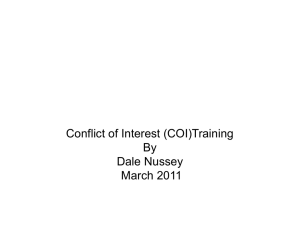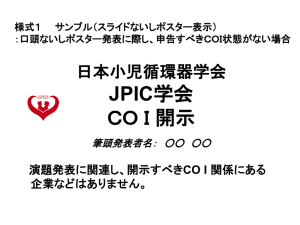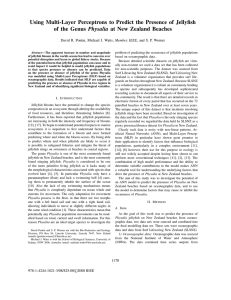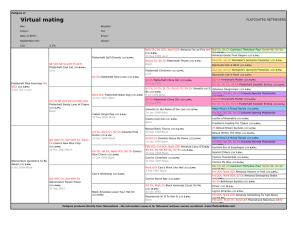Finding relationships and differences by bar
advertisement
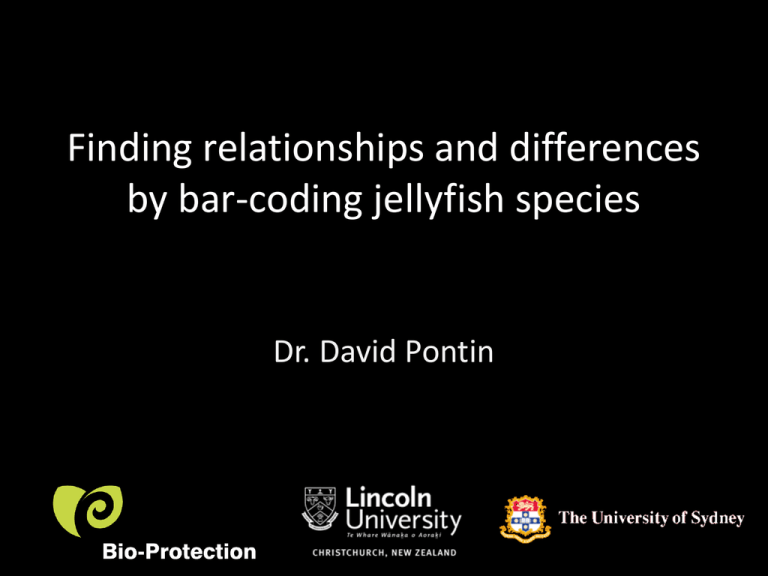
Finding relationships and differences by bar-coding jellyfish species Dr. David Pontin A beginning Barcodes • Barcode: A short series of vertical bars representing the digits 0-9, commonly used for product identification. • DNA Barcode: A short length of DNA that is able to differentiate between species. caggggcacgaatcagttaccaaatcctccaattagaact ggcattacaaggaaaaagatcataacaaatgcatgagca gttactataacattatagagatgatcatctccaaacatggt accaggtcctgacaa Looking for DNA Barcodes • • • • Mitochondrial DNA vs. Nuclear DNA “fast evolving” tips only of interest Must work in >90% of examples 650 bp length of Mitochondrial DNA called cytochrome c oxidase I or COI DNA Barcoding today • Formally Described Species :72,144 • Total Barcode Records 871,435 • Barcode of life project caggggcacgaatcagttaccaaatcctccaattagaact ggcattacaaggaaaaagatcataacaaatgcatgagca gttactataacattatagagatgatcatctccaaacatggt accaggtcctgacaa A bit of controversy • What constitutes a species? – Rule of thumb for insects is 2% divergence (13bp) • Cryptic species/species complexes – DNA vs. morphology • COI doesn't work for everything (plants) – Is one gene enough? Physalia (Siphonophora) • Completely pelagic • Taxonomically ambiguous • Abundant around New Zealand • Passive surface dispersal PhD. goals 1. Identify the species 2. Identify important oceanographic variables that influence bluebottle occurrence 3. Predict bluebottle occurrence Portuguese Man o War Physalia physalis The Bluebottle Physalia utriculus Bluebottle locations • 54 specimens • 13 locations • COI and ITS sequenced Midway Kauai East Auckland West Auckland Mt Maunganui Taranaki Bribie Island Brisbane Perth Himatangi Beach Abel Tasman Nelson Hokitika Riversdale Foxton New Brighton Likelihood trees R18 COI ITS MM2 MM1 R13 MM1 MM3 R18 MM2 R4 MM3 MM4 R13 R1 MM4 R4 WA1 H2 R20 AE15 HB3 AE10 WA6 NB10 H4 NB3 F5 NB8 NB7 H1 T4 R3 N3 B7 B9 WA1 Midway 1 Kauai 2 Kauai 1 B10 NB109 N2 B10 B6 B7 AE14 T3 F2 AT2 NB4 H53 NB32 NB22 T2 NB2 NB9 WA3 F5 H3 WA2 AW2 HB2 HB5 NB5 R2 F3 HB1 F1 Bribie Is 1 Bribie Is 2 Bribie Is 3 NB103 N1 NB2 NB4 NB9 F5 NB10 WA3 AT2 HB2 AW 2 HB3 F3 NB109 F2 Physalia physalis 1 change R3 R20 HB5 H53 NB22 H1 N1 NB7 H2 NB10 AE 10 WA6 H4 NB3 NB7 N2 T2 AW 15 WA2 AW 2 R2 HB1 F1 H3 NB8 Physalia physalis NB32 T3 T1 H2 WA2 T4 Genetic linkages (COI) Hybridisation? • Two explanations for the ones that “jumped ship” – Hybridisation – Ancestral polymorphisum • More likely to be hybridisation – Range overlap – Broad cast spawning – Reported in the Anthozoa Western Australia 1 • Doesn't fit any clan • If removed, green clan is well supported • What’s going on? R18 MM1 MM2 R4 MM3 R13 MM4 WA1 B10 B6 B7 NB2 NB4 NB9 F5 NB10 WA3 AT2 HB2 AW 2 HB3 F3 NB109 F2 R3 HB5 H53 NB22 H1 N1 NB7 H2 NB10 AE 10 WA6 H4 NB3 NB7 N2 T2 AW 15 WA2 AW 2 R2 HB1 F1 H3 NB8 R20 NB32 T3 T1 H2 WA2 T4 Conflict Tree 2 Tree 1 A C B A 60% 40% D B C D Achieving goals (or not) • We still don’t know what species of bluebottle occurs in New Zealand • But it is a species complex needing a global review • COI was a good choice but results heighted the need for other markers with “difficult” species Hypothesised movement of Physalia Hypothesised blooming zone Synergy Both techniques confirm the existence of two circulatory systems Molecular data shows what’s there and the models suggest how it got there Methods allow potential blooming areas to be inferred so that other evidence can be examined in a directed manner Not possible if methods are considered independently Wider Picture • How many other jellyfish species could be the same? What does that mean for New Zealand's marine biodiversity? • Population identification has several usages – Pest control: resistance – Population linkages
